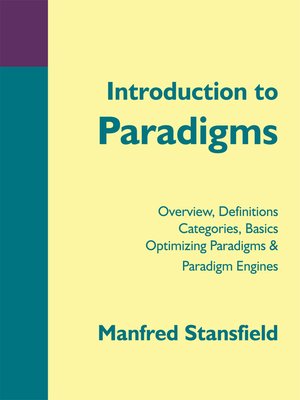Introduction to Paradigms
ebook ∣ Overview, Definitions, Categories, Basics, Optimizing Paradigms & Paradigm Engines
By Manfred Stansfield

Sign up to save your library
With an OverDrive account, you can save your favorite libraries for at-a-glance information about availability. Find out more about OverDrive accounts.
Find this title in Libby, the library reading app by OverDrive.



Search for a digital library with this title
Title found at these libraries:
| Library Name | Distance |
|---|---|
| Loading... |
Introduction to Paradigms is a generic look at the things that help to clear up the crippling
reality-paradigm confusion, which we all are susceptible to just in growing up. It demonstrates
that:
A paradigm is a model of a portion of reality, with fewer dimensions and a manageable size, mass
and energy.
Paradigms are necessary because they are the solution to the problem of having insufficient
human RAM and CPU to be omniscient and deal with reality on a direct perception/knowing
basis. The human solution is to create paradigms that do fit our RAM and CPU, so we can
change the undesirable elements of existence into desirable ones.
Unfortunately, paradigms can be more true or less true, by accident or design, and that's where
the rub is.
Less true paradigms come about in two ways:
Through the incompetence of well meaning paradigm designers or
By the deliberate introduction of bias into a paradigm to give inequitable power and money to
some who have not earned it. The bias is in the form of a lie in a paradigm or the miss-
definition of a word. More money is made today by theft through paradigm bias than by the
honest creation of wealth. It is not a victimless crime. The individual members of society as
well as the society as a whole lose in wealth, a lowered pursuit of happiness and a lowered
survival potential. Paradigm bias is a societal parasite and too many parasites kill the host.
Purveyors of paradigm bias are the same as confidence men. One trick they use is to convince
you, that what they are telling you is reality when it is a paradigm. Reality, one tends to accept
as true, while one questions what is known to be a paradigm. How do you tell the difference and
what if you don't?
Example: My telling you about a tree gives you my paradigm of a tree, which can be more true or
less true. On the other hand, the only way you get the reality of a tree is by seeing it for yourself;
climbing it; feeling the trunk, bark and leaves; eating the fruit; chewing on a leaf, twig, bark;
smelling the blossoms, cones, leaves, bark and roots; listening to the wind pass through the
branches and leaves; standing under the tree when the sun is too hot or when it is raining.
Example: The 9/11 suicide pilots believed that what they had been told since early childhood was
reality: That they would go to a paradise which was a much nicer place than this world and that
they would live forever with seven virgins and seven wives if they died committing a mass
murder as they were told. They did what they were told because they did not know the
difference between paradigm and reality.
Reality is what you experience yourself. Paradigms are anything you received through a
communication paradigm such as what some one told you or you read. We are all handicapped to
the extent we are victims of the paradigm-reality confusion and prone to be taken advantage of
through paradigm bias.
More true paradigms require a paradigm designer well acquainted with reality.
Is science the answer? Unfortunately, the scientific method applies only to explicate order
phenomena that can be repeated and verified by the lowest common denominator of scientist...







